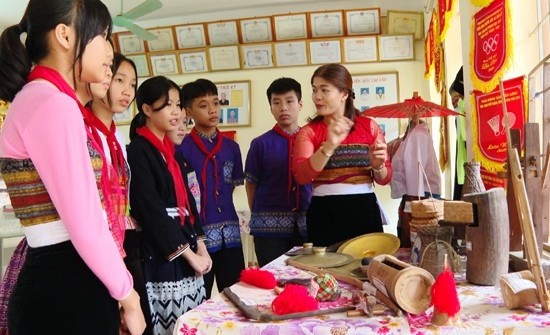
In Hoa Binh province, there are many ethnic groups living together. The largest ethnic group is the Muong, who account for 63.3% of the total population, followed by Kinh ethnic group with 27.73%; Thai ethnic group with 3.9%; Dao ethnic group with 1.7%; Tay ethnic group with 2.7%; and H’mong ethnic group with 0.52%. There are also Chinese and other ethnic groups living scattered in the province.
Hoa Binh province has synchronously implemented solutions to preserve and promote the value of cultural heritage through research, collection, and systematization of documents to evaluate the value of each intangible cultural heritage.
On that basis, it proposes solutions to preserve and exploit appropriate values and achieve practical results, serving traditional education, promoting tourism development and contributing to preserving cultural identity of ethnic groups, making culture the spiritual foundation of society, making cultural heritage, especially intangible cultural heritage, a rich resource and becoming an advantageous tourism product of the province.
Schools in Hoa Binh annually develop plans for ethnic cultural education activities to equip students with basic knowledge and understanding of the traditional culture of ethnic minorities, organize activities to display, introduce traditional festivals, customs, folk games, folk songs, folk dances and local specialties to students.
With the determination to bring traditional culture into schools, in recent years, the Mai Chau B Ethnic Minority Boarding Secondary and High Schools has integrated traditional culture into subjects to suit local conditions. Up to now, integrating traditional culture into teaching for students has become a regular activity of the schools in many diverse forms.
Recently, the education of life skills and traditional culture for ethnic minority students has been replicated at all ethnic minority boarding schools in the province.
Thanks to regular contact with cultural activities and through cultural activities, students at ethnic minority boarding schools have the opportunity to improve their understanding and preserve their ethnic identity, at the same time have the opportunity to interact, know and respect the cultures of other ethnic minorities.
Not only in the ethnic minority high school system, bringing traditional culture into schools is one of the contents of the movement "Building friendly schools, active students" implemented by the Hoa Binh education sector at schools throughout the province.
Especially, according to Decision 209/QD-BVHTTDL of the Ministry of Culture, Sports and Tourism on the implementation of the Project on "Preserving and promoting traditional costumes of Vietnamese ethnic minorities in the current period”, the Department of Education and Training of Hoa Binh province has propagated and encouraged school administrators in the province to wear national costumes to school; encouraged officials, teachers, and students to wear traditional ethnic costumes at least once a week at ethnic minority boarding schools; and encouraged ethnic minority students, teachers, and lecturers who are ethnic minorities at primary and secondary schools, high schools, vocational schools, and colleges in the province to wear their traditional costumes.
With the efforts of the entire education sector and the support from students, parents and the whole society, bringing traditional culture into schools aims to help each student foster pride in themselves about their cultural traditions.